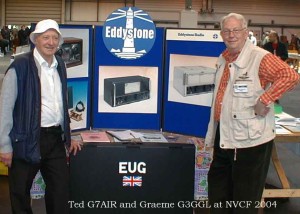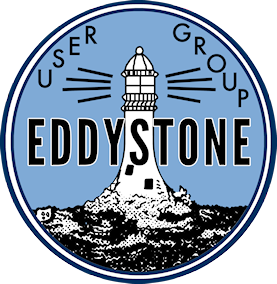The Eddystone User Group – A Brief History
The Eddystone User Group was formed in 1990 by Ted Moore, G7AIR and his wife Kathie. Ted had been collecting Eddystones for many years and had become acquainted with a dozen or two like-minded individuals.
He decided that it would be a good idea to produce a sort of round robin to circulate around the group so as to avoid interminable telephone calls! Thus was formed the E.U.G. with an eight-page newsletter. Ted wrote the newsletter on his portable typewriter and his XYL Kath looked after the copying and the membership list.
 Contact was made by Ted with the Eddystone Factory at “The Bath Tub”, the old West Heath Lido where Eddystone had settled after being bombed out of the city centre of Birmingham in 1940. The Managing Director, Chris Pettitt, GØEYO, being an active ham and having a sense of history agreed that information could be available to the group from the company’s technical publications section, which had a substantial archive of the many sets produced over the years.
Contact was made by Ted with the Eddystone Factory at “The Bath Tub”, the old West Heath Lido where Eddystone had settled after being bombed out of the city centre of Birmingham in 1940. The Managing Director, Chris Pettitt, GØEYO, being an active ham and having a sense of history agreed that information could be available to the group from the company’s technical publications section, which had a substantial archive of the many sets produced over the years.
The show was on the road and notices in the radio hobbies’ press produced a steady flow of new members. In the end the group became a victim of its own success. After four years the membership had grown to over 200 and Kath could no longer cope with the increased administration, printing and distribution, as well as doing a full-time job.
When Chris Pettitt learned that the Group was in danger of folding he arranged for Eddystone Radio to take over the administration, together with the printing and distribution of the now much enlarged newsletter. His secretary, Pat Hawkins did much of the administration and Christine Surman their Technical Publications assistant did the printing. I don’t think he ever got around to telling his masters at Marconi what he was up to! Things stabilised and the group continued to flourish with Ted still producing the text but on a newly acquired word-processor.
 After a couple of very successful years, with Graeme Wormald, G3GGL, helping Ted with some of the text, another shadow was cast over the Group. This time it was due to the future of Eddystone Radio in Birmingham. The premises at the Bath Tub actually belonged to Laughtons (who owned Stratton and Company, the original owners of Eddystone). When they sold the radio company to Marconi in 1965 they signed a lease for the Eddystone part of the site for 30 years. This was due to expire in 1995 and Stratton, still an active producer of fancy goods, wanted the site for expansion. This was the dawn of Digital Audio Broadcasting and Eddystone were also keen to move to more presitigous premises which reflected the companies high tech products.
After a couple of very successful years, with Graeme Wormald, G3GGL, helping Ted with some of the text, another shadow was cast over the Group. This time it was due to the future of Eddystone Radio in Birmingham. The premises at the Bath Tub actually belonged to Laughtons (who owned Stratton and Company, the original owners of Eddystone). When they sold the radio company to Marconi in 1965 they signed a lease for the Eddystone part of the site for 30 years. This was due to expire in 1995 and Stratton, still an active producer of fancy goods, wanted the site for expansion. This was the dawn of Digital Audio Broadcasting and Eddystone were also keen to move to more presitigous premises which reflected the companies high tech products.
In the event Eddystone acquired industrial and office premises at Selly Oak, a suburb of Birmingham on the Bristol Road about three miles from the Bath Tub. The removal was a major disruption, both to the company and the User Group. Graeme Wormald, still very much a fringe activist in the Group offered his services to help things over the hump. In fact after a couple of years there was a serious downturn in the company’s fortunes. Malaysia and the Far East had been a good market for the Company’s transmitter products and a severe drop in the Malaysian Ringitt resulted in the loss of a large order of FM broadcast transmitters for Malaysia and the slow start of DAB broadcasting, (pioneered by Eddystone and the BBC) meant that orders for fill-in multiplexes were delayed. Marconi were also seriously looking for buyers for Eddystone as they no longer saw broadcasting as a core business. Pressures mounted and after a failed management buyout, Chris eventually resigned as Managing Director in 1998.
With that Graeme’s role in the Group, far from being a passing phase, became almost a full-time job. Finally the owners, Marconi-GEC, went down-hill and sold Eddystone Radio to another Company which ended up in administration after another couple of years. Graeme took over the rest of the organising of the User Group until he felt that, in the year of Grace 2006, it was time for him to retire. As he had no apprentice to follow in his footsteps it was decided that the realistic way forward was for the EUG to cease being a subscription group and transfer to the WWW.
